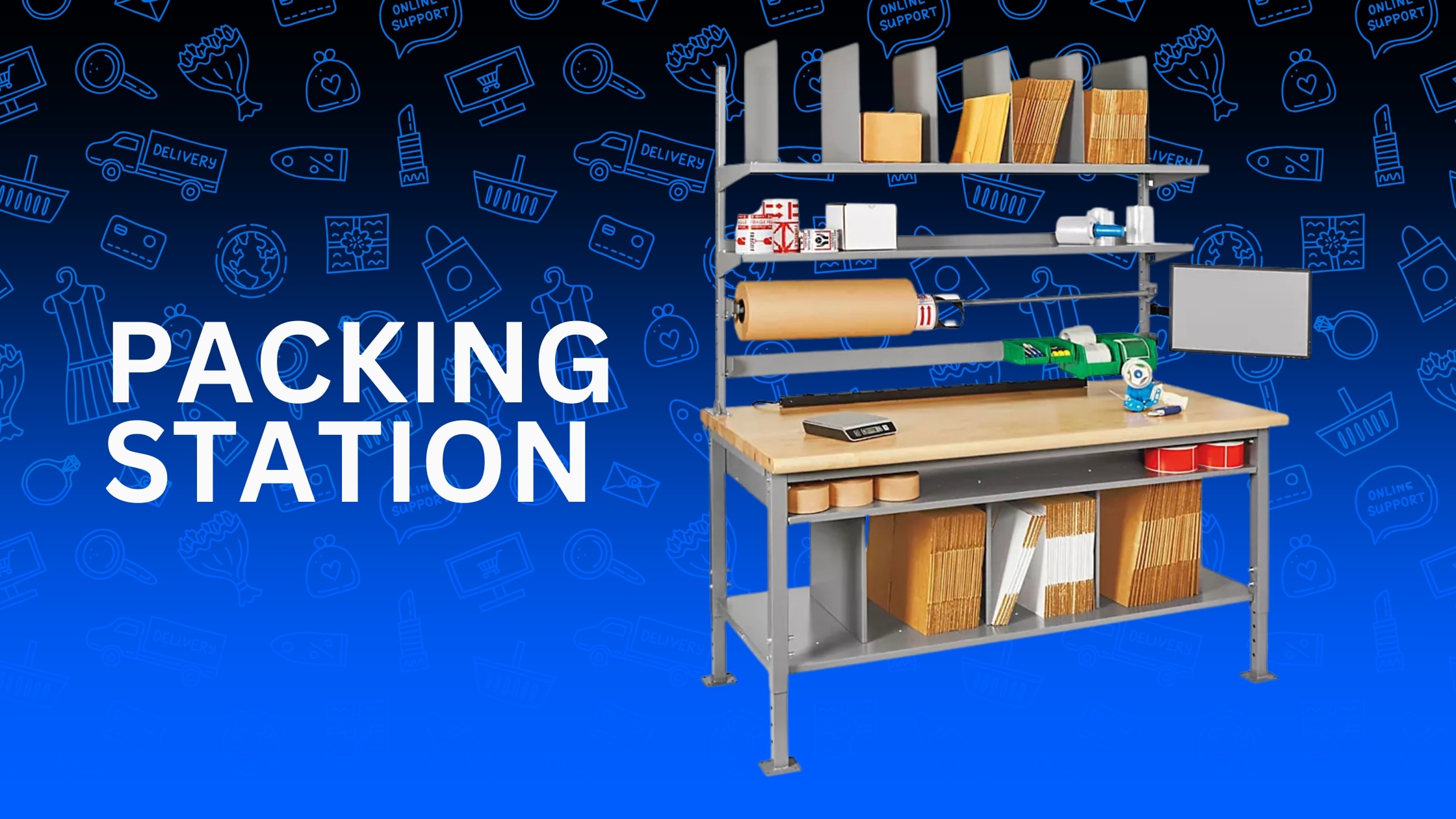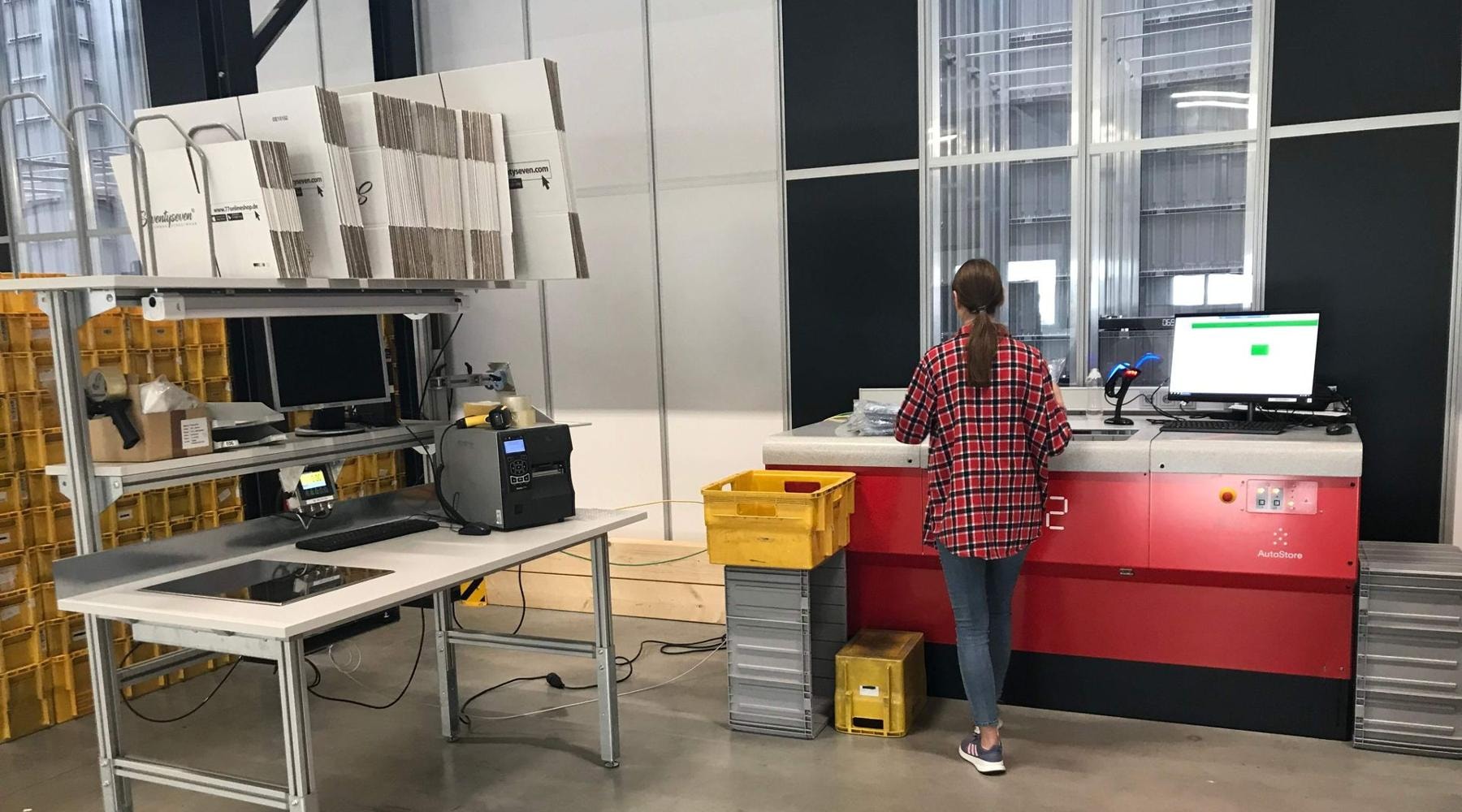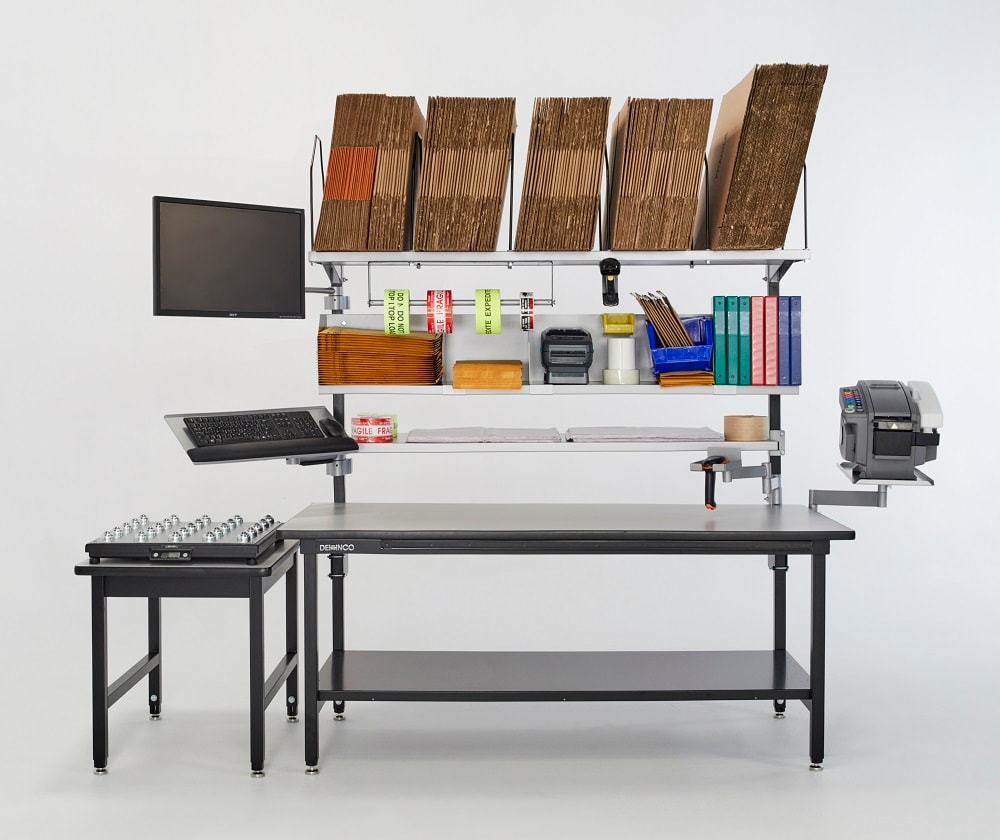Packing Station: Full Guide On Benefits, Set Up, And Best Practices
23 Dec 2024
|by diadmin

Efficient packing stations are a crucial component in the order fulfillment process, especially in high-volume warehouses where speed and accuracy are key. A well-structured packing station allows workers to pack, label, and prepare shipments with maximum efficiency, which directly impacts productivity and customer satisfaction. This guide walks you through what a packing station is, the benefits it brings to warehouse operations, and best practices for designing and implementing a packing station that truly enhances efficiency.
What is a Packing Station?
At its core, a packing station is a dedicated area within a warehouse designed for the packing stage of the order fulfillment process. Here, products are carefully packed, labeled, and prepared for shipment. This area is more than just a table with boxes; it’s a crucial part of any warehouse operation aimed at reducing labor costs, minimizing errors, and increasing productivity. Integrating packing stations with warehouse management systems can optimize processes, reduce costs, and ensure timely and accurate order fulfillment.
Packing stations are highly customizable, allowing businesses to tailor them to specific needs, including the types of products they handle and the volume of shipments they process. From packing tables and storage solutions to ergonomic design and packing supplies, a well-designed packing station can significantly improve the speed and efficiency of packing operations.
By understanding the essential role a packing station plays in the order fulfillment process, it’s clear that optimizing this area can have a big impact on warehouse efficiency. Next, let’s explore the specific benefits that a well-designed packing station can bring to your warehouse operations.
Benefits of Using a Warehouse Packing Station
Investing in an efficient warehouse packing station offers several benefits that can transform packing operations and drive better business outcomes.
Improved Efficiency and Speed
A dedicated packing station streamlines the packing process by minimizing unnecessary movements, improving the flow of operations, and ensuring all supplies and packing materials are within easy reach. This setup can greatly reduce time spent searching for packing materials or moving between areas, allowing for more shipments to be packed in less time.
Additionally, modular packing stations can further streamline the workflow by integrating packaging with order picking and shipping processes, allowing for customization to meet specific operational needs while maintaining an ergonomic workspace.
Reduced Labor Costs
With a well-organized packing station, workers can perform packing activities faster and more accurately, reducing labor costs associated with order processing. Efficient warehouse packing stations not only reduce the need for additional workers, but also contribute to lower shipping costs by ensuring that each order is packed efficiently.
Enhanced Customer Satisfaction
When orders are carefully packed and arrive intact and on time, customer satisfaction increases. An efficient packing station helps ensure each order is packed and labeled accurately, reducing errors that lead to delays or returns. This attention to detail ultimately enhances the customer experience.
Increased Worker Safety and Comfort
A well-designed packing station prioritizes ergonomic design, minimizing physical strain and worker fatigue. With features like adjustable packing tables and non-slip mats, workers can perform their tasks comfortably and safely, reducing the risk of injury and supporting long-term productivity.
With these benefits in mind, it’s clear that a well-organized packing station is a powerful asset for any warehouse. Now, let’s look at the essential steps in designing an efficient packing station that meets the unique needs of your warehouse operations.

Designing an Efficient Warehouse Packing Station
An efficient packing station isn’t just about having a table and some boxes. Designing it with the right layout and equipment can make all the difference in speeding up your packing process and keeping your team comfortable. Here’s what to focus on.
Layout and Workflow
The way your packing station is set up has a big impact on how smoothly work gets done. A good layout should make it easy for workers to reach everything they need without unnecessary steps. Start by arranging packing tables, shelves, and labeling tools in the order they’ll be used, so items can move smoothly from one step to the next.
Place essential packing materials—like boxes, tape, and bubble wrap—close to the work area. This cuts down on time spent looking for supplies and helps workers stay focused. If your warehouse handles different types of products, you may need extra space for bulky items or specific storage solutions for smaller goods to keep everything organized and accessible.
Equipment and Ergonomics
The right equipment not only helps workers pack efficiently, but also keeps them safe and comfortable. Ergonomic tools, like adjustable tables and anti-fatigue mats, reduce strain, making it easier for employees to work efficiently, even during long shifts.
Key equipment like label printers, barcode scanners, and holders for tape and bubble wrap make it easy to keep packing supplies at hand and speed up the packing process. Proper lighting is also essential to help workers see clearly, reducing mistakes and keeping the workspace safe and comfortable.
With an organized layout and the right tools, your packing station can run smoothly and efficiently. Next, let’s look at the main components every packing station needs to be effective.

Key Components of a Packing Station
To create an efficient packing station, it’s important to include the right components. Each part of the station plays a role in keeping packing fast, organized, and accurate. Here are the must-have components for a well-structured packing station.
Workbench and Shelving
A sturdy, reliable workbench is the foundation of any packing station. It needs to be strong enough to support various packing tasks, from handling large boxes to small items. Adjustable or heavy-duty workbenches work well because they allow workers to comfortably handle different types of products.
Adding shelves or storage units near the workbench helps keep packing materials—such as boxes, tape, and bubble wrap—organized and easy to reach. With supplies close by, workers can focus on packing without wasting time searching for what they need. Adjustable or modular shelving is ideal because it can be reconfigured as needs change, allowing flexibility in a busy packing environment.
Labeling and Packaging System
A labeling and packaging system is essential for speed and accuracy. With tools like label printers and barcode scanners at the packing station, workers can quickly label and track items, reducing the chances of packing errors. This setup helps ensure that each order is labeled correctly and ready to ship, making the packing process smoother and helping with order accuracy.
Tools such as tape dispensers, bubble wrap holders, and box cutters should be part of every packing station. These tools keep materials organized and make it easier to carefully pack items. For example, tape and bubble wrap within reach allow workers to secure items without delays, enhancing the customer experience by ensuring that items arrive safely.
Ergonomic Equipment for Worker Comfort
Supporting worker comfort is key to a productive packing station. Features like adjustable-height tables and anti-fatigue mats make the workspace safer and more comfortable, especially for long shifts.
Anti-fatigue mats can reduce strain for workers standing for extended periods, while proper lighting helps them see details clearly, reducing mistakes and creating a safer work environment.
With these components in place, your packing station will be ready to handle orders efficiently and accurately. Now, let’s look at how to set up your team and implement tools like automation to make the most of your packing station.
Implementing a Warehouse Packing Station
Setting up a packing station is just the beginning. To get the most out of it, you’ll need to organize tasks, train your team, and consider the benefits of automation. Here’s how to set up a smooth and efficient packing operation.
Assigning Tasks and Training Workers
A well-organized packing station requires a skilled and trained team. Start by assigning tasks that match each worker’s strengths and experience. For example, some workers might be faster at labeling, while others are more efficient with boxing and taping items. Dividing tasks helps everyone work more effectively and keeps the packing line moving.
Training is essential for both speed and safety. Make sure each worker knows how to use the equipment and understands the packing process, from handling fragile items to using barcode scanners and label printers. Clear training on procedures and safety standards ensures that every team member can perform their role confidently and efficiently, helping reduce errors and accidents.
Integrating Robotics and Automation
For warehouses with high-volume packing needs, automation can take efficiency to the next level. Automation tools, like robotic arms for packing and automated label applicators, can handle repetitive tasks quickly and accurately. By automating these processes, you reduce manual labor, improve accuracy, and keep orders moving faster.
Automation not only speeds up packing, but also helps with accuracy. For example, a robotic arm can label packages perfectly every time, reducing errors and ensuring each package is ready to ship. This setup also allows your team to focus on tasks that require more attention or expertise, boosting productivity and reducing labor costs in the long run.
With tasks organized, workers trained, and automation in place, your packing station will run more smoothly and efficiently. Next, let’s review some best practices for maintaining an organized and productive station.
Best Practices for Warehouse Packing Stations
Keeping a packing station organized and efficient isn’t just a one-time setup—it requires ongoing maintenance and attention to detail. Here are some best practices to ensure your packing station remains productive and effective over time.
Maintaining a Clean and Organized Workspace
A clutter-free packing area is essential for speed and accuracy. Regularly cleaning and organizing your station helps workers stay focused, reduces the chances of errors, and keeps packing supplies within easy reach. Make it a habit to tidy up at the end of each shift, ensuring everything is in its designated place and ready for the next day.
Use storage bins and shelving to keep packing materials organized, such as separate areas for boxes, tape, bubble wrap, and labels. This setup allows workers to easily locate supplies and prevents time wasted searching for items. Keeping tools like box cutters, tape dispensers, and barcode scanners in a designated area further minimizes clutter and improves efficiency.
Regular Maintenance and Inspections
Regular inspections of packing equipment ensure that everything is functioning properly and safely. Check items like label printers, barcode scanners, and workbenches to confirm they are in good condition. Well-maintained equipment helps avoid delays caused by unexpected breakdowns and keeps the packing process running smoothly.
Conducting safety checks on ergonomic equipment, like adjustable-height tables and anti-fatigue mats, can help prevent worker injuries and improve comfort. Ensuring that lighting and ventilation are adequate also contributes to a safer, more pleasant workspace.
Encouraging Continuous Improvement
Efficiency in a packing station can always be improved. Encourage your team to provide feedback on the packing process and suggest any adjustments that could make their tasks easier or faster. Small changes, like repositioning frequently used supplies or adjusting the layout, can have a big impact on productivity over time.
By maintaining a clean and organized workspace, performing regular maintenance, and embracing continuous improvement, you can keep your packing station running at its best. Now, let’s wrap up by highlighting the importance of a well-designed packing station and the lasting benefits it brings to your warehouse operations.
Conclusion
A well-designed packing station is essential for any warehouse aiming to improve efficiency, accuracy, and worker satisfaction. By investing in an organized, ergonomic, and optimized packing area, businesses can speed up the packing process, reduce labor costs, and ensure each order is packed with care and precision.
Following the best practices and setup strategies outlined in this guide, you can create a packing station that not only meets today’s demands but also adapts to future needs. From minimizing clutter to integrating automation, each component of a well-structured station plays a role in boosting productivity and supporting a smooth order fulfillment process.
With a focus on organization, safety, and efficiency, your warehouse can become a powerful asset that contributes to higher customer satisfaction and long-term operational success. Contact Us!
FAQs
1. What is a packing station?
A packing station is a dedicated area in a warehouse where products are prepared for shipment. This space is crucial to the order fulfillment process, as it’s where items are carefully packed, labeled, and organized for delivery. A well-designed warehouse packing station includes essential packing materials like boxes, tape, and bubble wrap, along with tools such as label printers and barcode scanners. By organizing packing activities and ensuring that all supplies are within easy reach, it helps improve efficiency, reduce labor costs, and increase customer satisfaction by supporting faster, more accurate order processing.
2. What are the key components of an efficient warehouse packing station?
An efficient warehouse typically includes a sturdy workbench, organized shelving for packing materials, labeling and packaging tools like label printers and barcode scanners, and ergonomic equipment such as adjustable tables and anti-fatigue mats. These components help streamline the packing process, reduce worker fatigue, and ensure an accurate and smooth order fulfillment process.
3. How can I improve efficiency and reduce labor costs at a warehouse packing station?
To improve efficiency and reduce labor costs at your warehouse packing station, focus on optimizing the layout, keeping packing supplies and tools within easy reach, and integrating automation where possible. Using labeling systems, barcode scanners, and ergonomic equipment can also speed up the packing process and help workers stay comfortable, boosting productivity and reducing errors.
4. What are the benefits of an ergonomic packing station for warehouse operations?
An ergonomic packing station in a warehouse can significantly improve worker comfort, reduce physical strain, and minimize the risk of injuries. By using adjustable-height packing tables, anti-fatigue mats, and organized packing materials, ergonomic stations support higher productivity and long-term operational efficiency, contributing to a safer and more efficient workspace.